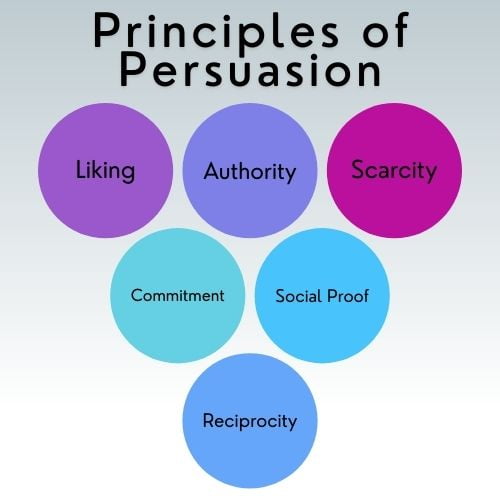Do you struggle to get your ideas accepted by others?
Whether you’re trying to convince your boss to approve a new project or persuade your friends to try a new restaurant, the ability to persuade others is a valuable skill.
In this article, we’ll explore various persuasion tactics that you can use to get people to do what you want. From understanding the psychology of persuasion to mastering effective communication techniques, we’ll show you how to become more influential and effective at convincing others.

Jump To Section
Understanding the Psychology of Persuasion
Understanding the psychology behind persuasion is crucial to achieving success. Persuasion is more than just convincing someone of something; it’s about getting them to act in a certain way. Knowing your audience is critical when it comes to persuasion. To truly impact others, it is essential to understand what drives their decision-making process.
The Importance of Knowing Your Audience
When it comes to persuasion, one size does not fit all. Every person has their own unique set of experiences, beliefs, and values that guide their decision-making. Understanding this is key to tailoring your message in a way that resonates with the listener. Take the time to research your audience to gain insights into what motivates them and what they care about. By doing so, you are more likely to create a message that resonates and influences them.
The Different Levels of Persuasion
There are different levels of persuasion, from the most superficial to the most profound. The shallowest level involves simple agreement without any real change in behavior. For instance, someone may nod in agreement when you ask them to do something but not actually follow through. The most profound level of persuasion involves a change in behavior and attitude. For example, convincing someone to quit smoking for the sake of their health involves a significant shift in both behavior and attitude.
The Significance of Building Relationships
Building relationships with your audience before attempting to persuade them is crucial. People are more likely to be influenced by someone they trust and respect. Building a relationship is not about manipulation, but rather creating a genuine connection with the person you are trying to persuade. When the person realizes that you care about their well-being, they are more likely to be open to your message.
By understanding the psychology of persuasion, you will be able to develop tailored messages that resonate with your audience. When you recognize that each person has their own unique set of beliefs and values, you are more equipped to create a message that resonates with them. Additionally, building a relationship with your audience fosters mutual trust and respect that increases the likelihood of acceptance.
Using Cognitive Psychology to Your Advantage
Cognitive psychology involves the study of mental processes such as attention, perception, and memory. Understanding how the brain processes information is essential in persuasion. Here are some ways to use cognitive psychology to your advantage:
The Power of Framing
Framing your message means presenting it in a way that highlights the benefits and positive outcomes of doing what you propose. A simple change of words or phrases can create an entirely different frame. For example, instead of saying “I need you to do this,” say “This is something that will benefit both of us.” This simple change of framing can make the listener feel like they are invested in the result, rather than feeling like they are being bossed around.
Harnessing the Power of Emotion
Emotions play a powerful role in decision-making processes. Positive or negative emotions can impact how willing a person is to act on what you are suggesting. Using emotionally charged language can elicit the desired emotional response from your audience. For instance, discussing the negative consequences of not doing something can elicit a sense of fear or anxiety, making the person more likely to comply.
Using Social Proof to Your Advantage
Humans have an innate tendency to conform to social norms. If we see others doing something, we are more likely to follow suit. Using social proof by showing that others are also doing what you are proposing can be a powerful tool in persuasion. This is particularly true if the person you are trying to persuade views those doing the action in a positive light.
By harnessing the power of cognitive psychology, you can develop a more effective and persuasive message. Framing your message, using emotional language, and utilizing social proof all play important roles in influencing others. When you understand the impact of cognitive psychology in persuasion, you are better equipped to create a message that resonates with your audience.
Techniques for Effective Persuasion
Being able to effectively persuade others is a valuable skill that can open doors and create opportunities.
Here are some techniques that have been proven to be effective in the art of persuasion:
- Establish Credibility
- Appeal to Emotions
- Utilize Social Proof
- Provide Evidence
- Find Common Ground
- Offer Win-Win Solutions
Let’s break each technique down a little further.
1. Establish Credibility
One of the first steps in persuasive communication is establishing credibility. People are more likely to be influenced by someone they perceive as knowledgeable and trustworthy. Share your expertise, credentials, or relevant experiences to enhance your credibility. By establishing yourself as a credible source, your audience will be more likely to trust and accept your message.
2. Appeal to Emotions
Emotions play a critical role in decision-making. When trying to persuade someone, appeal to their emotions by telling compelling stories or using vivid language. By connecting with their emotions, you can create a deeper and more persuasive impact. However, it’s important to strike a balance and use emotions ethically, avoiding manipulation or deceit.
3. Use Social Proof
People often look to others for guidance when making decisions. Utilize the power of social proof by showcasing testimonials, case studies, or examples of others who have benefited from your proposal. When individuals see that others have already accepted and benefited from your message, they are more likely to follow suit.
4. Provide Evidence and Logic
Support your arguments with solid evidence and logical reasoning. Present facts, statistics, and research to back up your claims. By providing logical and well-supported arguments, you can increase the persuasive power of your message. Be sure to present your evidence in a clear and concise manner to enhance its impact.
5. Find Common Ground
Effective persuasion often involves finding common ground with your audience. Understand their perspective, beliefs, and values, and find areas where your goals align. By emphasizing shared values and agreeing on common objectives, you can build a sense of trust and cooperation, increasing the likelihood of persuasion.
6. Offer a Win-Win Solution
Instead of focusing solely on your own goals, consider the needs and interests of your audience. Offer a win-win solution where both parties can benefit. Highlight how your proposal will address their concerns and provide them with tangible benefits. By emphasizing mutual gain, you can create a more persuasive argument.
Effective persuasion requires a combination of credibility, emotional appeal, evidence, logic, finding common ground, and offering win-win solutions. By utilizing these techniques, you can significantly enhance your ability to influence others and achieve your desired outcomes.
Avoiding Common Mistakes in Persuasion
While persuasion can be a powerful tool, there are several common mistakes that can undermine its effectiveness. Here are some mistakes to avoid when trying to persuade others:
1. Assuming a One-Size-Fits-All Approach
Every person is unique, and what works on one person may not work on another. Avoid assuming that a single approach will work on all individuals. Tailor your message to each individual, taking into account their personality, beliefs, and values.
2. Focusing on the Wrong Goal
When trying to persuade someone, it’s essential to focus on the right goal. Avoid focusing on what you want them to do, and instead focus on what they want or need. By identifying their goals and motivations, you’ll be better equipped to present your message in a way that resonates with them.
3. Ignoring Objections
Ignoring objections can be a fatal mistake in persuasion. Recognize and address any potential objections upfront, rather than hoping they won’t come up. By acknowledging objections and providing credible responses, you can foster a sense of trust and improve the likelihood of persuasion.
4. Using Manipulative Tactics
Manipulative tactics, such as using fear or shame, are unethical and can undermine your credibility. Instead of using manipulative tactics, focus on building trust and rapport with your audience. Strive to present your message in a way that is clear, concise, and honest.
5. Forgetting to Follow Up
Following up after a persuasive message can be crucial to achieving success. A message might be well-received but ultimately ignored if there is no follow-up. Make sure to follow up after presenting your message to keep communication lines open and reinforce the message.
6. Failing to Listen
Effective persuasion requires listening actively to understand the audience’s perspective and concerns. Failing to listen can create misunderstandings and undermine your credibility. By actively listening and showing empathy, you can build rapport and gain an understanding of what motivates your audience.
By avoiding these common mistakes, you can significantly improve your ability to persuade others. Rather than using manipulative tactics or ignoring objections, focus on building a relationship with your audience, addressing their concerns, and finding mutually beneficial solutions.
Conclusion
In conclusion, the art of persuasion is a powerful tool that, when used effectively, can open doors and create opportunities. By mastering these strategies and avoiding the common mistakes, you can significantly enhance your ability to influence others and achieve your desired outcomes. With practice and a thoughtful approach, the art of persuasion can lead to greater success in all areas of life.


